Final Iteration for Artwork 2
An Arena For High Stakes Chess
Starting Materials:
- Arena board, from the game Krosmaster Arena
- Chess set
- Deck of 52 playing cards
Rules:
Players play rock paper scissors to see who goes first, that winner may choose black or white, it doesn’t matter.
Players then set-up the board;
This is done by first placing down obstacles for the opposing player,
This is done by using the Arena accessories such as trees, crate, and bushes.
The player who lost the rock, paper, scissors game may set down up to 5 pieces(3 trees, 1 bush, 1 crate) in any spot that he/she wishes first. Then the other player does the same.
Then both players setup the board as they would in regular chess,
The players must stay in the first two rows on their side, but they can as be spread out as they want, there are “12” spots, for 8 pieces per row, so there will be space.
The two kings must be facing each other, and must have a pawn in front of them. (this is to prevent the king from being taken immediately).
The rest is set up in the standard order
Once set up the players can start the game.
Changes to the Chess Rules:
All pieces that had restricted movement can now move an extra space if they wish,
(this is for pawn, king, and knight)
Pawns can now also start by moving up to 4 spaces forward on their first move if they so choose to.
If there is an obstacle in the way, the piece can move around it by making adjacent steps around the obstacle.
Knights can choose to move up to the 4 steps they can make, meaning they can move less than 4 steps, but they always have to move at right angles.
Knights can now also jump over crates and bushes.
When capturing an opponent’s piece, the players must play a round of 5 card poker.
This means both players draw 5 cards, and the anti is the 2 pieces that are “fighting” each other. As in 5 card poker, each player can exchange up to 5 cards with the “dealer”. The dealer can be designated through whatever means. The player who does the “attacking” gets to exchange cards first. The player with the better hand, keeps their piece in the spot, and the losers piece is “taken” or discarded.
Then play continues as normal.
Checks, or checkmates, are played the same way, if the king is being checked, and the player doing the checking has the better hand, then the king is lost, and the other player wins.
The rest of the game is played regularly.
Documentation:
Materials:

The board:
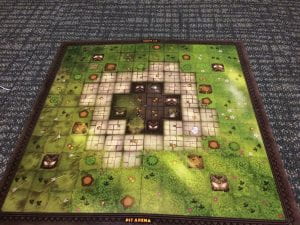
The first player setting up the obstacles on the opposing side:
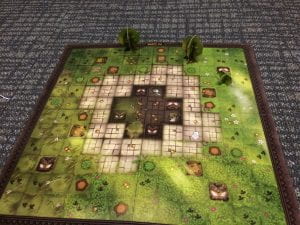
The second player setting up obstacles:
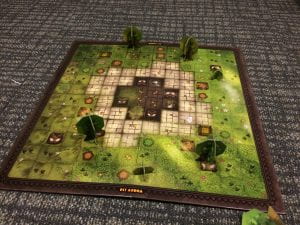
The pieces are set up:
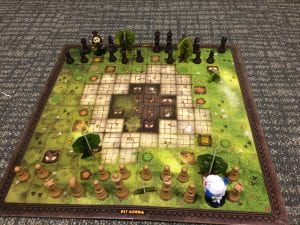
An example of an attack, white pawn taking black:
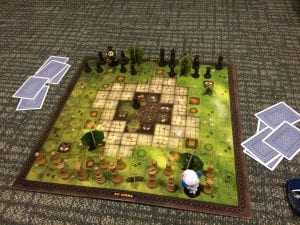
After cards are distributed and exchanged the winner is decided:

White has taken the black pawn, and now it is the black sides turn:
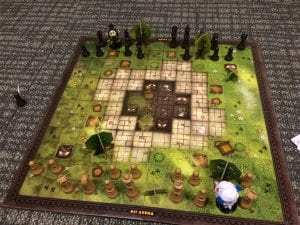
These are a few shots of gameplay in class:
Annie making a move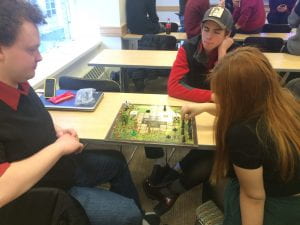
Manning’s turn, taking time to think it through
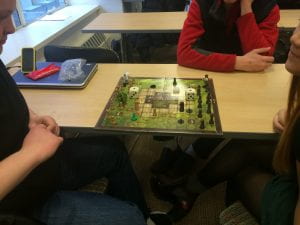
5-Card poker, gamble over their pieces
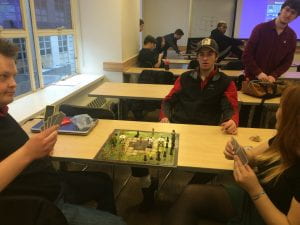
The hands are shown, higher hand wins
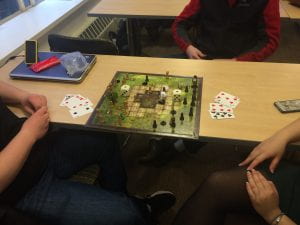
Artist Statement:
This piece was inspired by several different artists of the Fluxus movement. The main inspiration is of course Marcel Duchamp, who worked so much with chess, that he eventually became a chess master. The piece he made with Johnny Cage, called Reunion contributed somewhat, as well as Yoko Ono’s White Chess. The Fluxchess sets were different and aspired to make the player feel something new, to create a sense of flux in something that had existed for hundreds of years if not more. For my piece, I wanted to emulate war, and at the same time, the randomness of life. I wanted my chess board to represent a battlefield, a place where soldiers fight each other, often for a pointless cause. I wanted the reality of life, which is represented by the “randomly” placed obstacles, to be present in the game. And I wanted each encounter to be decided by chance and just a hint of strategy, much like the wars that have persisted throughout humanity’s history. This ties in with the larger board, a 12×12 , because of how in real life wars have been fought by large battalions and hundreds of thousands of people have died. A simple 8×8 board is too small to emulate such battlefields. The obstacles that are placed by the opposing player can be seen as “fate” or “luck” and can simulate how our lives are shaped by the obstacles around us. I also quite enjoyed the grassy aesthetic of the board, and think that it is more interesting than a simple grid pattern. My overall goal was to create an aggressive, quick game, that is often decided by chance. This is quite different that Yoko Ono’s White Chess in which the players must be focused and play slow to keep track of who is who. I think the amalgam of the games that are presented works well and creates a fun piece of art and a fun game.
